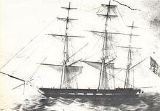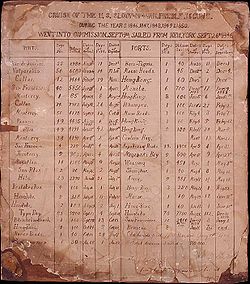
James Glynn
Encyclopedia
James Glynn was a U.S. Navy
officer who in 1848 distinguished himself by being the first American to negotiate successfully with the Japan
ese during the "Closed Country
" period.
James Glynn entered the United States Navy
on March 4, 1815. He became a lieutenant in 1825, a commander in 1841, and served on the California
coast during the Mexican-American War. He was put in command of the sloop-of-war
USS Preble
(16 guns) and sent to China
.
 In Canton
In Canton
, he learnt from the Dutch
consul about the imprisonment at Nagasaki of 18 American sailors from the whaleship Lagoda
, who had been shipwrecked on the northern Japanese island of Yeso on June 5, 1846. Although the coast of Japan was poorly known, and the American Commander James Biddle
, with the ships USS Columbus
and USS Vincennes
had been recently repelled by the Japanese in the bay of Edo
(Tokyo
), Glynn was ordered by David Geisinger
to leave for Nagasaki, where he arrived on April 17, 1849.
The sailing orders to Captain Glynn recommended both caution and firmness in his enterprise:
 The Japanese tried to block the entrance to Glynn's ship, but he forced his way through a row of boats and anchored in the middle of the bay of Nagasaki. Despite Japanese menaces, he insistently demanded the release of the prisoners, and threatened an intervention of the United States. With some help from the Dutch in the negotiations, the prisoners were finally delivered to him on April 26.
The Japanese tried to block the entrance to Glynn's ship, but he forced his way through a row of boats and anchored in the middle of the bay of Nagasaki. Despite Japanese menaces, he insistently demanded the release of the prisoners, and threatened an intervention of the United States. With some help from the Dutch in the negotiations, the prisoners were finally delivered to him on April 26.
The sailors had suffered throughout their internment, and after several attempts to escape were put in cages where several died of exposure. Another had hanged himself, and was left hanging in his cage for two days. Ranald MacDonald
was also among the party of the rescued, although he had travelled to Japan of his own will and taught English to several Japanese during his internment in Nagasaki, becoming the first American to teach English in Japan.
The Preble returned to Hong Kong
and the prisoners finally returned to the United States on December 31, 1849, where the story of their harsh internment made a sensation.
Following his voyage, Glynn made a proposition to the United States government to open relations with Japan through diplomacy, and, if necessary, by a show of strength. His recommendation paved the way for the expedition of Commodore Matthew Perry
in 1853 and 1854.
Glynn was made a captain in 1855.
United States Navy
The United States Navy is the naval warfare service branch of the United States Armed Forces and one of the seven uniformed services of the United States. The U.S. Navy is the largest in the world; its battle fleet tonnage is greater than that of the next 13 largest navies combined. The U.S...
officer who in 1848 distinguished himself by being the first American to negotiate successfully with the Japan
Japan
Japan is an island nation in East Asia. Located in the Pacific Ocean, it lies to the east of the Sea of Japan, China, North Korea, South Korea and Russia, stretching from the Sea of Okhotsk in the north to the East China Sea and Taiwan in the south...
ese during the "Closed Country
Sakoku
was the foreign relations policy of Japan under which no foreigner could enter nor could any Japanese leave the country on penalty of death. The policy was enacted by the Tokugawa shogunate under Tokugawa Iemitsu through a number of edicts and policies from 1633–39 and remained in effect until...
" period.
James Glynn entered the United States Navy
United States Navy
The United States Navy is the naval warfare service branch of the United States Armed Forces and one of the seven uniformed services of the United States. The U.S. Navy is the largest in the world; its battle fleet tonnage is greater than that of the next 13 largest navies combined. The U.S...
on March 4, 1815. He became a lieutenant in 1825, a commander in 1841, and served on the California
California
California is a state located on the West Coast of the United States. It is by far the most populous U.S. state, and the third-largest by land area...
coast during the Mexican-American War. He was put in command of the sloop-of-war
Sloop-of-war
In the 18th and most of the 19th centuries, a sloop-of-war was a warship with a single gun deck that carried up to eighteen guns. As the rating system covered all vessels with 20 guns and above, this meant that the term sloop-of-war actually encompassed all the unrated combat vessels including the...
USS Preble
USS Preble (1839)
USS Preble was a United States Navy sloop-of-war with 16 guns, built by the Portsmouth Navy Yard, Kittery, Maine, launched June 13, 1839 and commissioned in 1840. She was named after Commodore Edward Preble ....
(16 guns) and sent to China
China
Chinese civilization may refer to:* China for more general discussion of the country.* Chinese culture* Greater China, the transnational community of ethnic Chinese.* History of China* Sinosphere, the area historically affected by Chinese culture...
.

Guangzhou
Guangzhou , known historically as Canton or Kwangchow, is the capital and largest city of the Guangdong province in the People's Republic of China. Located in southern China on the Pearl River, about north-northwest of Hong Kong, Guangzhou is a key national transportation hub and trading port...
, he learnt from the Dutch
Netherlands
The Netherlands is a constituent country of the Kingdom of the Netherlands, located mainly in North-West Europe and with several islands in the Caribbean. Mainland Netherlands borders the North Sea to the north and west, Belgium to the south, and Germany to the east, and shares maritime borders...
consul about the imprisonment at Nagasaki of 18 American sailors from the whaleship Lagoda
Lagoda
The Lagoda is a half-scale model of the whaling ship of the same name, located at the New Bedford Whaling Museum.-Original ship:The original Lagoda was a merchant ship built in 1826...
, who had been shipwrecked on the northern Japanese island of Yeso on June 5, 1846. Although the coast of Japan was poorly known, and the American Commander James Biddle
James Biddle
James Biddle , of the Biddle family, brother of financier Nicholas Biddle and nephew of Captain Nicholas Biddle, was an American commodore. His flagship was USS Columbus.-Education and early career:...
, with the ships USS Columbus
USS Columbus (1819)
The second USS Columbus was a 74-gun ship of the line in the United States Navy.-History:She was launched on 1 March 1819 by Washington Navy Yard and commissioned on 7 September 1819, Master Commandant J. H...
and USS Vincennes
USS Vincennes (1826)
USS Vincennes was a 703-ton Boston-class sloop of war in the United States Navy from 1826 to 1865. During her service, Vincennes patrolled the Pacific, explored the Antarctic, and blockaded the Confederate Gulf coast in the Civil War. Named for the Revolutionary War Battle of Vincennes, she was...
had been recently repelled by the Japanese in the bay of Edo
Edo
, also romanized as Yedo or Yeddo, is the former name of the Japanese capital Tokyo, and was the seat of power for the Tokugawa shogunate which ruled Japan from 1603 to 1868...
(Tokyo
Tokyo
, ; officially , is one of the 47 prefectures of Japan. Tokyo is the capital of Japan, the center of the Greater Tokyo Area, and the largest metropolitan area of Japan. It is the seat of the Japanese government and the Imperial Palace, and the home of the Japanese Imperial Family...
), Glynn was ordered by David Geisinger
David Geisinger
David Geisinger was an officer of the United States Navy, who served during the War of 1812, and was later Commodore of the East India Squadron.-Biography:...
to leave for Nagasaki, where he arrived on April 17, 1849.
The sailing orders to Captain Glynn recommended both caution and firmness in his enterprise:
- "In your correspondence with the Japanese, your conduct will be conciliatory but firm. You will be careful not to violate the laws or customs of the Country, or by any means prejudice the success of any pacific policy our government may be inclined to pursue. Nevertheless you may be placed in situations which cannot be foreseen. In all such cases, every confidence is reposed in your discretion and ability to guard the interests as well as the honor of your country" (National Archives Microfilm Publication M89; Larson 1994 [1981]).

The sailors had suffered throughout their internment, and after several attempts to escape were put in cages where several died of exposure. Another had hanged himself, and was left hanging in his cage for two days. Ranald MacDonald
Ranald MacDonald
Ranald MacDonald was the first man to teach the English language in Japan, including educating Einosuke Moriyama, one of the chief interpreters to handle the negotiations between Commodore Perry and the Tokugawa Shogunate.-Early life:MacDonald was born at Fort Astoria, in the Pacific Northwest of...
was also among the party of the rescued, although he had travelled to Japan of his own will and taught English to several Japanese during his internment in Nagasaki, becoming the first American to teach English in Japan.
The Preble returned to Hong Kong
Hong Kong
Hong Kong is one of two Special Administrative Regions of the People's Republic of China , the other being Macau. A city-state situated on China's south coast and enclosed by the Pearl River Delta and South China Sea, it is renowned for its expansive skyline and deep natural harbour...
and the prisoners finally returned to the United States on December 31, 1849, where the story of their harsh internment made a sensation.
Following his voyage, Glynn made a proposition to the United States government to open relations with Japan through diplomacy, and, if necessary, by a show of strength. His recommendation paved the way for the expedition of Commodore Matthew Perry
Matthew Perry (naval officer)
Matthew Calbraith Perry was the Commodore of the U.S. Navy and served commanding a number of US naval ships. He served several wars, most notably in the Mexican-American War and the War of 1812. He played a leading role in the opening of Japan to the West with the Convention of Kanagawa in 1854...
in 1853 and 1854.
Glynn was made a captain in 1855.

